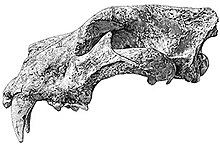Loading AI tools
Fossil cat From Wikipedia, the free encyclopedia
Panthera fossilis (also known as Panthera leo fossilis or Panthera spelaea fossilis) is an extinct species of cat belonging to the genus Panthera, known from remains found in Eurasia spanning the Middle Pleistocene and possibly into the Early Pleistocene.
| Panthera fossilis Temporal range: | |
|---|---|
 | |
| Skull from Azé, France | |
 | |
| Life restoration | |
| Scientific classification | |
| Domain: | Eukaryota |
| Kingdom: | Animalia |
| Phylum: | Chordata |
| Class: | Mammalia |
| Order: | Carnivora |
| Suborder: | Feliformia |
| Family: | Felidae |
| Subfamily: | Pantherinae |
| Genus: | Panthera |
| Species: | †P. fossilis |
| Binomial name | |
| †Panthera fossilis (Reichenau, 1906) | |
| Synonyms | |
| |
Although often historically considered a subspecies of the living lion (Panthera leo), Panthera fossilis is currently either considered to be ancestral to[1] or a subspecies of Panthera spelaea (commonly known as the cave lion or steppe lion).[2][3] In comparison to Late Pleistocene Panthera spelaea specimens, Panthera fossilis tends to be considerably larger,[2] up to 400–500 kilograms (880–1,100 lb), considerably exceeding modern lions in size, and making them among the largest cats to have ever lived.[4][5]
It was first described from remains excavated near Mauer in Germany.[6] Bone fragments of P. fossilis were also excavated near Pakefield in the United Kingdom, which are estimated at 680,000 years old.[7] In Poland, remains of P. fossilis have been found at various sites dating to between 750,000 to 240,000 years ago.[8] Bone fragments excavated near Isernia in Italy are estimated at between 600,000 and 620,000 years old.[9] The first Asian record of a fossilis lion was found in the Kuznetsk Basin in western Siberia and dates to the late Early Pleistocene.[10]
P. fossilis is estimated to have evolved in Eurasia about 600,000 years ago from a large pantherine cat that originated in the Tanzanian Olduvai Gorge about 1.2–1.7 million years ago. This cat entered Eurasia about 780,000–700,000 years ago and gave rise to several lion-like forms. The first fossils that can be definitively classified as P. fossilis date to circa 660,000–612,000 years ago.[3] Possibly earlier records of P. fossilis. are known from the late Early Pleistocene (over 780,000 years ago) of Western Siberia.[10] Recent nuclear genomic evidence suggest that interbreeding between modern lions and all Eurasian fossil lions took place up until 500,000 years ago, but by 470,000 years ago, no subsequent interbreeding between the two lineages occurred.[10][11]
Remains of P. fossilis indicate that it was larger than the modern lion and was among the largest known cats ever, with the largest specimens suggested to have a body length of 2.5–2.9 metres (8.2–9.5 ft), shoulder height of 1.4–1.5 metres (4.6–4.9 ft) and body mass of 400–500 kilograms (880–1,100 lb).[5] Skeletal remains of P. fossilis populations in Siberia measure larger than those in Central Europe.[10][12] Compared to a modern lion, P. fossilis had a slightly wider skull and nasal cavity, smaller orbits, less inflated bullae, less specialized lower teeth, reduced lower premolars and smaller incisors.[13]
P. fossilis was historically considered an early lion (P. leo) subspecies as Panthera leo fossilis.[9] Some authors considered it a subspecies of Panthera spelaea (Panthera spelaea fossilis) or treat it as a distinct species.[14][15] Some employ a subgenus of Panthera, "Leo", to contain several lion-like members of Panthera, including P. leo, P. spelaea, P. atrox and P. fossilis.[10] A 2022 study concluded that P. fossilis and P. spelaea represented a chronospecies lineage, with most differences between the two species explainable by size differences.[1]
Results of mitochondrial genome sequences derived from two Beringian specimens of Panthera spelaea indicate that it and Panthera fossilis were distinct enough from the modern lion to be considered separate species.[16]
Herbivores that coexisted with the lion included the hippopotamus, rhinoceroses of the genus Stephanorhinus (such as Merck's rhinoceros and the narrow-nosed rhinoceros), straight-tusked elephant, moose, steppe bison, red deer, roe deer and fallow deer. Sympatric predators included brown bears, wolves, cave hyenas, the sabertooth Homotherium, European leopards, and the "European jaguar" Panthera gombaszoegensis.[17][10][12][18][19][20]
The only evidence of human interaction with Panthera fossilis is from Gran Dolina, Spain, dating to Marine Isotope Stage 9 (~300,000 years ago), where a specimen of Panthera fossilis displays cut marks thought to be produced archaic humans, who are suggested to have butchered the animal for its flesh.[21]
Seamless Wikipedia browsing. On steroids.
Every time you click a link to Wikipedia, Wiktionary or Wikiquote in your browser's search results, it will show the modern Wikiwand interface.
Wikiwand extension is a five stars, simple, with minimum permission required to keep your browsing private, safe and transparent.